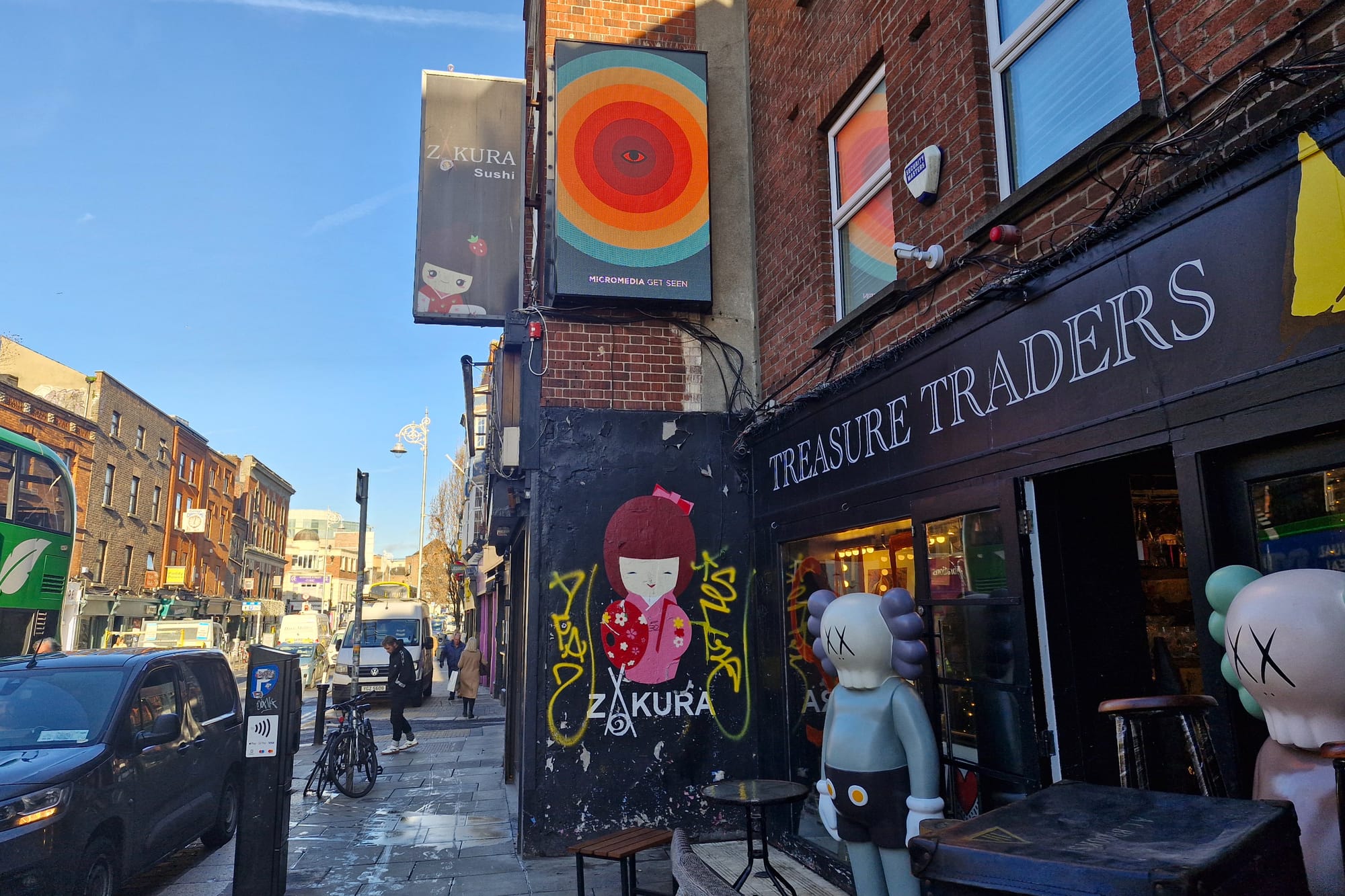In Ballymun, lining up to read and reconnect with the constitution
“Some people have said it's a bit like karaoke.”
Digital screens are impacting on our environment,” says independent Councillor Mannix Flynn. “It’s another erosion of the public domain.”

At Lincoln Place, a road that forks northwards from the National Gallery in the heart of town, an illuminated billboard flashes above a cafe.
The council granted permission in 2024 to replace an existing billboard with this digital one.
One moment, it advertises ChatGPT. The next, it promotes Range Rover.
Across the city at 13 Wexford Street, on the gable wall between Zakura restaurant and Treasure Traders, an illuminated sign advertises a film, flicks to a music festival and then to Micromedia.
The council also granted permission in 2024 to replace an existing billboard with this digital one.
These billboards – and others – have appeared, despite provisions in the council’s city development plan, in place since 2022, to control advertising signs in the city centre.
The plan divides the city into a series of zones, and defines whether outdoor advertising should be allowed in each – and under what conditions.
The Wexford Street billboard is Zone 3, where the development of outdoor advertising is “open for consideration”.
The Lincoln Place billboard, though, is in Zone 1, where “there is a strong presumption against outdoor advertising”.
However, the development plan also provides for advertisers to do deals with the council when they want to upgrade their billboards – say, from regular ones, to digital ones.
“Any upgrading and/ or replacement of existing outdoor advertising” will only be permitted if “an agreement is made to decommission at least one other display panel in the city”, the plan says.

So on Lincoln Place, despite the presumption against outdoor advertising, the council planner judged the swap – removal of another billboard, at 151 Pearse Street – a big enough gain, to make allowing the upgrade to a digital billboard worth it.
Still though, some councillors say they oppose the gradual creep of illuminated signs on the cityscape.
“Digital screens are impacting on our environment,” says independent Councillor Mannix Flynn. “It’s another erosion of the public domain.”
Green Party Councillor Janet Horner says that she is worried about the impact of digital signage. “It is the cheapening of the entire public realm,” she says. “I’d rather if there were fewer of them.”
Dublin City Council didn’t respond in time for publication to queries sent Tuesday as to why it is allowing illuminated billboards to replace ordinary ones.
Digital illuminated signs cause problems for people living in the city, says Flynn, the independent councillor.
Earlier this year, he supported residents on Lower Kevin Street who objected to an application for a digital sign very close to their homes, he says.
That application was refused, despite a proposed swap. Planners noted the proximity of the signs, with changing displays, to homes.
Flynn says he also supports residents in Rathmines who said they were majorly affected by the council’s decision to allow an ordinary billboard be exchanged for an illuminated one.
Residents are still living with the screens flashing, visible from their windows, he says. “There needs to be a proper strategy and enforcement.”
That situation hasn’t been resolved, he says. “It is much, much more intrusive,” says Flynn.
Horner, the Green Party councilor, says that the billboard on the Drumcondra railway bridge has recently been illuminated. “You have an LED screen beaming out at you.”
If public bodies are to profit from advertising, they should invest the money locally, she says. “Drumcondra Station is particularly bleak.”
Planning documents show some of the arguments and swaps being put forward, for proposed digital displays.
Dublin City Council earlier this year granted JC Decaux permission to install new illuminated billboards at 397 North Circular Road and Annesley Bridge Road because the company agreed to remove other billboards at Gardiner Place, which were on a site that is attached to a protected structure, the planning documents say.

And in exchange for getting to upgrade one billboard at 13 Wexford Street to an illuminated digital one, Lucid Media took away one on the other side of the building.
In the application for the screens at Kevin Street, JC Decaux proposed multiple swaps. It said it was willing to decommission an illuminated sign at 138 South Circular Road for that one.
It would also be willing to decommission another 12 billboards in exchange for eight digital ones, it says.
“They have also submitted a list of site where planning applications will be lodged and the reciprocal list of advertising displays which are proposed for permanent decommissioning,” says the planners report.
Paula Geraghty says that, years ago, she was involved in objecting to billboards and other on-street advertising signs after Dublin City Council struck a controversial deal with billboard company JC Decaux to allow advertising structures in public places.
“It's the privatisation of public space,” she says.

Organisations representing the visually impaired also objected, she says, as some of the adverts were not on billboards but standalone objects, called metropanels and metropoles that clutter footpaths.
On foot of the deal, JC Decaux was granted planning permission for 78 billboards, according to an internal council audit of the scheme, published by IrishCycle.com.
The company was also to provide 50 bike-share stations, a wayfinding trail, remove 50 sheet billboards, and give a share of net advertising, the audit says.
Dublin City Council refused to publish all the details of the deal at the time, says Flynn. “As councillors we never had sight of the contract.”
In February last year, Dublin City Council granted JC Decaux retention planning permission for a free-standing advertising structure at Smithfield Square. In October 2023, it granted retention for a metropole on Richmond Road near Tolka Park.
Flynn says the council should stop all permissions for metropanels and especially metropoles.
They are particularly objectionable, because of their size and they clutter the public streets, he says. “We need to have a really stringent policy and practice.”